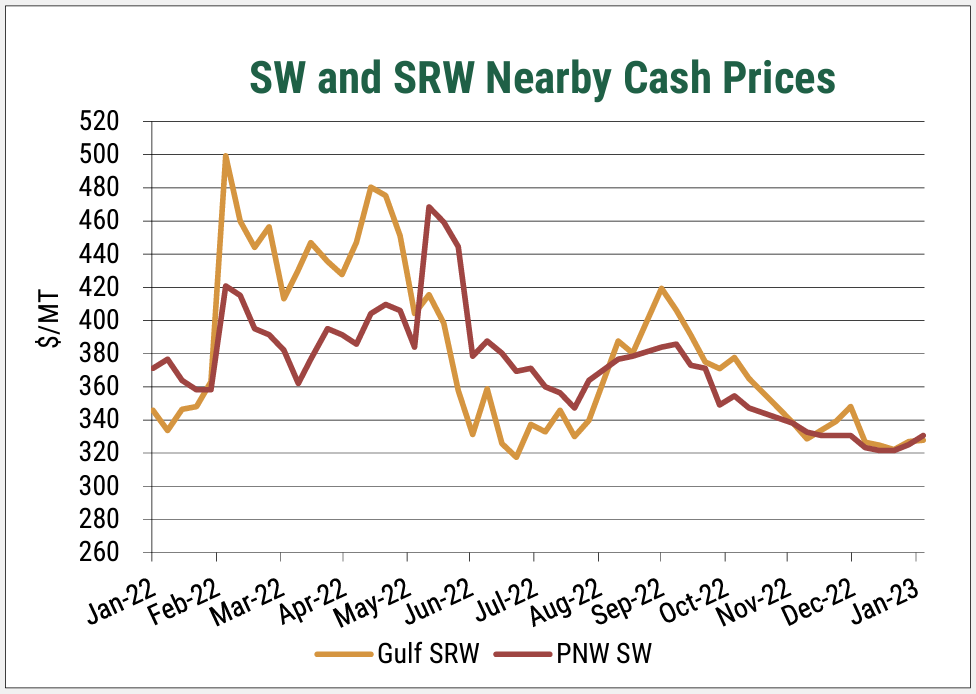Washington State University Economist Expects U.S. Wheat Prices Will Fall
By Matthew Weaver, Copyright © Capital Press, February 8, 2023, Excerpts Reprinted with Permission
Wheat prices “probably won’t be quite as good [for farmers]” in 2023 as they were last year, a top grain economist says.
“We won’t see last year’s prices, we’ll be several dollars short of that,” said Randy Fortenbery, the Thomas B. Mick Endowed Chair in Small Grain Economics at Washington State University, told farmers during the Spokane Ag Show. “We can’t be thinking we’re going to see 2022 wheat prices … unless there’s some other shock that’s not being anticipated.”
Soft white wheat ranged from $8.45 to $8.55 per bushel on the Portland market as of Feb. 8. Fortenbery advised farmers to be careful about assuming they’ll see prices above $10 a bushel. He expects wheat prices to trade within a $3 to $3.50 a bushel range. About $9.25 to $10 per bushel would be the high end, he said. [Editor’s Note: USDA lowered its February forecast of average farm gate wheat prices in 2023 to $9.00 per bushel.]
A Different of Opinion
The International Grains Council and USDA have conflicting forecasts for global wheat trade, Fortenbery said.
The council expects total world ending wheat stocks to be up 3% compared to last year and a 1.3% reduction in world wheat trade, which suggests a decline in prices. USDA projects world wheat stocks to be down 2.6% and trade to be up 5%, which suggests a price increase. Fortenbery said he leans toward the international council’s projections.
Both agencies agree the combination of Russia and Ukraine wheat exports will be up compared to last year. The flow of grain out of the Black Sea market appears to have stabilized the price impact of the conflict, Fortenbery said.
SW, SRW Back at Parity
The relationship between Portland white wheat prices and Chicago [soft red winter] wheat futures prices is returning to normal, after white wheat reached a peak of $3 above Chicago futures prices in recent years. The norm for Portland is closer to $1 above Chicago.
Because of the extreme difference, soft white prices didn’t respond last year when Russia invaded Ukraine, while Chicago [soft red winter] wheat prices “exploded,” rising to meet the higher white wheat prices, Fortenbery said. The relative prices are back in synch with each other, he said.

U.S. soft white and SRW export prices have converged in 2022/23 to near-parity. Source: U.S. Wheat Associates (USW) Price Report – February 3, 2023.
“If the Black Sea ends up being a problem again this spring, we’ll get some bump out of that,” he said.
The market doesn’t currently expect that, but risk remains, Fortenbery said.
Commodity prices generally look favorable in the next few months, but input costs are also at historic highs, Fortenbery said. Almost every major expense category was significantly higher last year compared to 2021; some were up to 60% or more.
He’ll be watching general inflation, which affects interest rates and production loans, and natural gas and refined fertilizer shipments from the Black Sea.
For additional information on U.S. wheat export price trends, see this Wheat Letter post from January 30, 2023: Wheat Prices Trend Lower Even As Uncertainty Continues.


